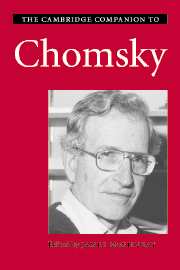Book contents
- Frontmatter
- Introduction
- Part I Chomsky on the human language
- 1 Chomsky’s science of language
- 2 Plato’s Problem, UG, and the language organ
- 3 Grammar, levels, and biology
- 4 How the brain begets language
- 5 Chomsky and Halle’s revolution in phonology
- 6 Universal aspects of word learning
- Part II Chomsky on the human mind
- Part III Chomsky on values and politics
- Notes
- References
- Index
5 - Chomsky and Halle’s revolution in phonology
from Part I - Chomsky on the human language
Published online by Cambridge University Press: 28 May 2007
- Frontmatter
- Introduction
- Part I Chomsky on the human language
- 1 Chomsky’s science of language
- 2 Plato’s Problem, UG, and the language organ
- 3 Grammar, levels, and biology
- 4 How the brain begets language
- 5 Chomsky and Halle’s revolution in phonology
- 6 Universal aspects of word learning
- Part II Chomsky on the human mind
- Part III Chomsky on values and politics
- Notes
- References
- Index
Summary
Introduction
Chomsky and Halle’s approach to phonological theory, as with other components of generative grammar, represented a sharp break with the main currents of American linguistics that immediately preceded them. The differences were conceptual as well as technical. Accounts of the development of phonology emphasize technical issues, such as arguments over the existence of a “taxonomic phonemic level,” or whether it is permissible to “mix levels” in a phonological analysis. Lying behind discussion of these issues, however, were assumptions about psychology and the practice of science. Indeed, throughout the development of phonology, major changes came about not only through technical breakthroughs, but also by reinterpreting the significance of existing technical devices. This was also the case with Chomsky and Halle’s innovations.
In this chapter I discuss Chomsky and Halle’s contributions to phonological theory by putting their views in the context of the theories that prevailed before them. I will also try to connect the technical issues to the larger conceptual ones concerning the nature of language acquisition and the mind. I will be treating Chomsky and Halle’s contributions together, without attempting to distinguish who contributed precisely which ideas. Their early work in generative phonology, culminating in the major work The Sound Pattern of English (Chomsky & Halle 1968, henceforth SPE), was done jointly.
- Type
- Chapter
- Information
- The Cambridge Companion to Chomsky , pp. 102 - 122Publisher: Cambridge University PressPrint publication year: 2005
- 80
- Cited by

